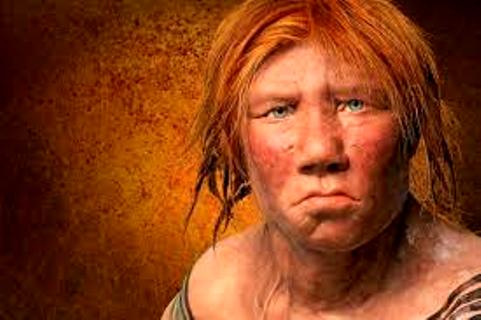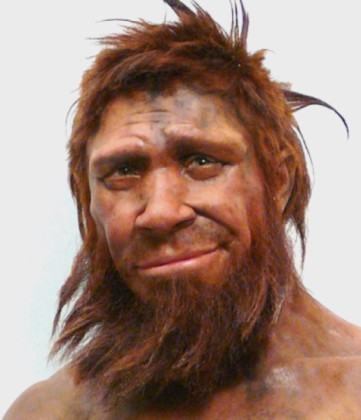

On this month's Oddities in the News Page:
Red Hair and Neanderthal genes
IN THE ODDITIES ARCHIVES
Animals and Coronavirus
Dog Noses
Fisherman’s Unique Catch
Dr. Helen Sharman
Banana Art
Twinkie
What’s really in Loch Ness

Why do some men have red beards when they don't have red hair?
...and beneath that....
Are those who do have red hair related to Neanderthals?
Live Science, May 2020: It's relatively rare to see a redhead — just 1% to 2% of humans are natural gingers. So, you might do a double-take if you see a man sporting a reddish or even a full-blown red beard, even though he is clearly not a carrot top.
What's the science behind these curious beards, especially among men with dark, blond or even graying mops?
This follicular fluke hasn't escaped the notice of researchers like Nina Jablonski, professor of anthropology at Penn State University, whose research has focused on the biology of hair hues. "I have observed many, especially younger, men with red beards and red hair and some with reddish beards and light brown, blond or red-blond hair," she told Live Science.
Most redheads live in Celtic countries such as Scotland, Ireland and Wales, followed by England and the Nordic nations, according to The Telegraph. Perhaps predictably, these red tresses exist because of a genetic mutation. Specifically, a mutation in a gene known as "MC1R," which controls pigment production in hair cells, among other things such as fair skin, poor tanning ability and pain perception, which may explain why a local anesthetic is less effective for redheads.
Hair color is determined by the ratio of two different pigments; eumelanin is responsible for black tones and pheomelanin causes red ones. People with black or dark brown hair will probably have only eumelanin, or at least it will be the dominant pigment. Blonds, meanwhile, have less of both types of pigment than their darker-haired and redheaded friends. And redheads, of course, have mostly pheomelanin.
One role of the MC1R gene is to code for a protein called melanocortin, whose job is to convert the red pigment into the black one. But if a person has a double mutation in this gene, its resulting proteins aren't as effective, which lead to red locks.
So, what happens when a person has a red beard, paired with a brown head of hair?
The same gene is behaving differently in different parts of the body and that's probably because there's just a single mutation of the MC1R gene, rather than a double mutation — meaning that the person is effectively a carrier of the redhead gene.

Some Neanderthals Were Redheads
Live Science: Like bringing to life a naked mannequin, scientists are using genetic and physical evidence found in fossils to clothe the skeletal remains of our closest hominid relatives, the Neanderthals.
More and more, they seen familiar.
Bones from two Neanderthals yielded valuable genetic information that adds red hair, light skin and perhaps some freckling to our extinct relatives. The results, detailed online today by the journal Science, suggest that some Neanderthals were redheads.
Holger Rompler of the University of Leipzig, Carles Lalueza-Fox of the University of Barcelona in Spain, and their colleagues extracted the mc1r gene from the bones of a 43,000-year-old Neanderthal from El Sidron, Spain, and a 50,000-year-old specimen from Monti Lessini, Italy. They found that both Neanderthal specimens contained a unique variant of the gene.
The gene is responsible for producing a protein that helps regulate the balance between the red-and-yellow pigment pheomelanin and the black-and-brown eumelanin. Modern people with relatively inactive mc1r receptors tend to have red hair and pale skin.

What about inbreeding?
-
Neanderthals have contributed between 1-4% of the DNA of humans of Eurasian descent
-
Neanderthals have not contributed to the genome of African modern human populations because they never lived there and could not have interbred with the ancestors of those populations
Neanderthals have contributed approximately 1-4% of the genomes of non-African modern humans, although a modern human who lived about 40,000 years ago has been found to have between 6-9% Neanderthal DNA (Fu et al 2015).
The evidence we have of Neanderthal-modern human interbreeding sheds light on the expansion of modern humans out of Africa. These new discoveries refute many previous hypotheses in which anatomically modern humans replaced archaic hominins, like Neanderthals, without any interbreeding. However, even with some interbreeding between modern humans and now-extinct hominins, most of our genome still derives from Africa.
Neanderthals could not have contributed to modern African peoples’ genomes because Neanderthals evolved and lived exclusively in Eurasia and therefore could not have bred with the humans living in Africa at that time.
For many years, the only evidence of human-Neanderthal hybridization existed within modern human genes. However, in 2016 researchers published a new set of Neanderthal DNA sequences from Altai Cave in Siberia, as well as from Spain and Croatia, that show evidence of human-Neanderthal interbreeding as far back as 100,000 years ago -- farther back than many previous estimates of humans’ migration out of Africa (Kuhlwilm et al 2016).
Their findings are the first to show human gene flow into the Neanderthal genome as opposed to Neanderthal DNA into the human genome. This data tells us that not only were human-Neanderthal interbreeding events more frequent than previously thought, but also that an early migration of humans did in fact leave Africa before the population that survived and gave rise to all contemporary non-African modern humans.
Because mtDNA is passed down exclusively from mother to offspring, if Neanderthal males were the only ones contributing to the human genome, their contributions would not be present in the mtDNA line. It is also possible that while interbreeding between Neanderthal males and human females could have produced fertile offspring, interbreeding between Neanderthal females and modern human males might not have produced fertile offspring, which would mean that the Neanderthal mtDNA could not be passed down. So it is mostly the Neanderthal males that bred with human females that passed the genes.
From the Smithsonian